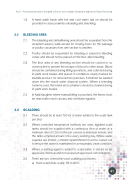Part 2 | Processing Procedures Designed to Ensure an Acceptable Standard of Hygiene in Poultry Processing 1.5 A hand wash basin with hot and cold water laid on should be provided in close proximity unloading and shackling. 2.0 BLEEDING AREA 2.1 The bleeding and defeathering area should be separated from the reception area by walls except for closing doors for the passage of poultry carcasses from one section to another. 2.2 Poultry should be suspended for bleeding or placed in bleeding cones and should not be placed on the oor after bleeding. 2.3 The oor area of any bleeding section should be curbed or so constructed to prevent the escape of blood to other areas. Blood should be contained during killing operations, and collected during in-plant work breaks and placed in containers clearly marked for inedible product, for removal from premises. It shall not be washed down into the waste water disposal system. Where a bleeding tunnel is used, the tunnel and containers should be cleaned during in-plant work breaks. 2.4 In halal slaughter where manual killing is practised, the knives must be rinsed after each carcass and sterilised regularly. 3.0 SCALDING 3.1 There should be at least 750 ml of water added to the scald tank per bird. 3.2 Where controlled temperature methods are used, agitated scald tanks should be supplied with a continuous ow of water at a minimum rate of 0.25 of a litre per carcass scalded per minute, and the tanks emptied at least once every working day. Where water supplies are limited, constant replenishment must be carried out to ensure the water is maintained in a reasonably clean condition. 3.3 Where a wetting agent is added to scald water, it should be an approved chemical and not exceed an approved concentration. 3.4 There are two commonly-used scalding procedures: a) Hard scald (Sub-scald): 55 to 60°C 41
